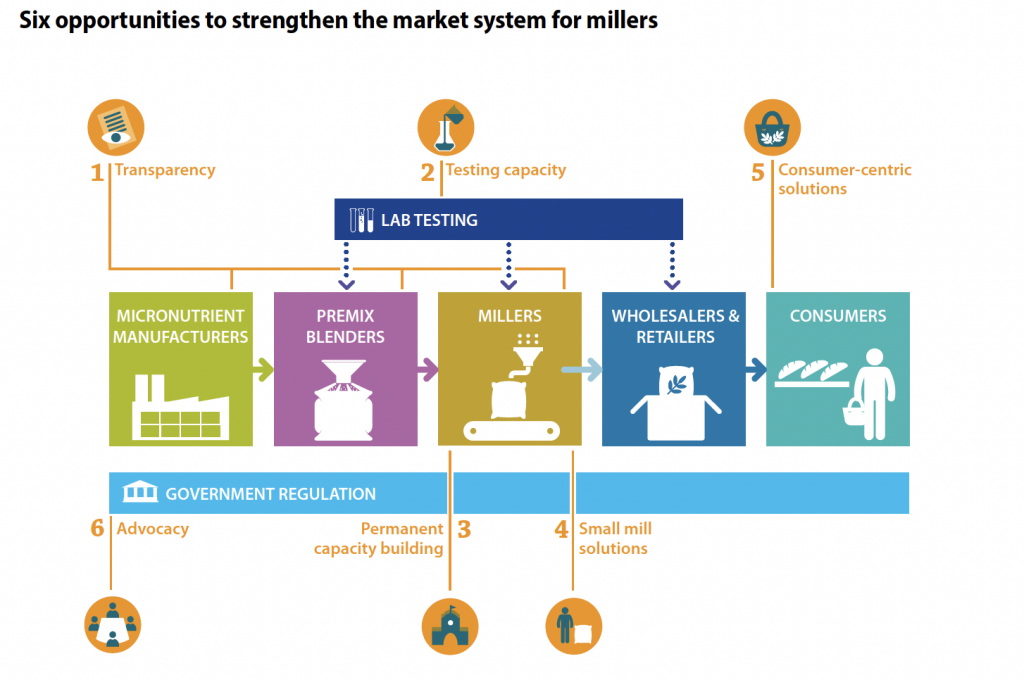How do we scale up the fortification of staples with vital nutrients and avoid micronutrient deficiencies during these challenging times where many people don’t have access to a balanced diet? Over the past decades, a solid regulatory framework has been created in many countries for the fortification of staples like salt, flour, sugar, oil or rice. Today, 154 countries have a standard for at least one food vehicle, and 143 countries have made fortification of at least one staple food mandatory. With this regulatory framework in place, we now need to focus on implementation. Here, the collaboration of and with millers is essential. And public-private partnerships can create the necessary ecosystem to fully get millers on board.
Food fortification background
About 3 billion people suffer from micronutrient deficiency. A lack of essential micronutrients like folate, iodine, iron, vitamin A, or zinc can lead to severe health disorders, such as blindness, anemia, goiter, as well as stunting and wasting among children. The causes for deficiencies are diverse and complex. Fortifying staples with essential nutrients is a relatively easy and cost-effective way to prevent severe deficiencies.
By learning from existing public-private partnership initiatives for food fortification and consulting with experts, our research has identified six opportunities to create incentives and strengthen local value chains. When implemented together with existing work on food standards, regulation, and technical assistance, they create an ecosystem where millers find it easier to fortify and get rewarded and recognized for it.
1 Increase transparency of food fortification results:
Millers can collaborate with not-for-profit organizations and other stakeholders in the industry to create neutral data platforms and share data on fortification results. This transparency, enriched with independent measurement results, builds trust and levels the playing field. In Nigeria, the micronutrient fortification index (MFI) has been launched based on the commitment of leading industry players at the CEO Roundtable for Nutrition. Implementation was facilitated by TechnoServe as part of the SAPFF programme.
2 Build local food fortification testing capacity
Local laboratories and and portable testing solutions can make testing quick and affordable. Regular tests enable millers to respond quickly to production issues and government officials to hold millers accountable. Development partners can work with private sector players to help establish this local capacity. In Tanzania, the Strategic Alliance for Fortified Oil and Other Staple foods (SAFO), a partnership between development agency GIZ and nutrient producer BASF, provided portable testing devices for vitamin A and as well as the required user training.
3 Support more permanent capacity-building institutions for food fortification
Permanent capacity-building institutions, on-site or online, allow millers to access the assistance on demand. It also empowers local experts and enables them to build networks, skills, and insight over time. The National Institute for Food and Technology & Entrepreneurship Management (NIFTEM) in India builds capacity by bringing together resources and capabilities of three stakeholders – a development sector agency, a nutraceutical manufacturer, and a national institute. They undertake research and innovation in the nutrition sector and provide education and information to local millers and food processors.
4 Enable fortification solutions structured specifically for small mills
Small mills often cater to the rural, peri-urban, and low-income markets, where the prevalence of micronutrient deficiencies is high. However, they are difficult to reach and support efficiently. Specialized small enterprise solutions can help. Social enterprise Sanku, for example, has developed a model for small industrial mills whereby premix is bundled into the cost of the empty flour bags that millers buy to pack their flour. Premix company Mühlenchemie supports the model by providing premix in special bags. Small-scale solutions often require another type of blended public-private or philanthropic financing mechanism since small mills will usually not be able to pay upfront for premix.
5 Develop new customer-centric solutions that create demand for fortified foods
Consumer-centric solutions can create demand and awareness for fortified foods. Africa Improved Foods (AIF) Rwanda limited is a public-private partnership that raises awareness by producing new products that are in high demand, aspirational or new staples, such as porridges. At the same time, the venture works with the public and civil sectors to raise nutrition awareness and has since reached 1.6 mill consumers across the region annually.
6 Advocate for effective policies, regulation and standards
Private and civil society actors can come together to advocate for reliable framework legislation and effective enforcement mechanisms. Smarter Futures is a public-private partnership that aims to raise awareness of the benefits of grain fortification across Africa. Public, private, and civil society actors collaborate to provide information and practical support to governments to advance food fortification regulation.
These opportunities only achieve their full potential when implemented together. No single solution can shift the system and overcome entrenched barriers. A concerted effort by international and national companies and civil society development organizations is needed to create a better market environment for food fortification.
This article was originally published by Business Fights Poverty on September 18, 2023, as a contribution to the discussion titled “Acting together to achieve large scale food fortification excellence.” This conversation was an integral part of the Global Goals Summit, held in conjunction with UNGA 78, which took place on September 21st, 2023. During the event, the Report Fortifying Food Markets was officially published and can be accessed through this link.
Authors: Christina Tewes-Gradl, Founder and Managing Director, Richard Gilbert, Senior Consultant, Endeva, and Jane Nelson, Director, Corporate Responsibility Initiative at the Harvard Kennedy School
Cover image source: Christina Tewes-Gradl, Richard Gilbert and Jane Nelson (2023) Fortifying Food Markets – Unlocking the potential of food fortification partnerships to improve nutrition. The CR Initiative at the Harvard Kennedy School.


